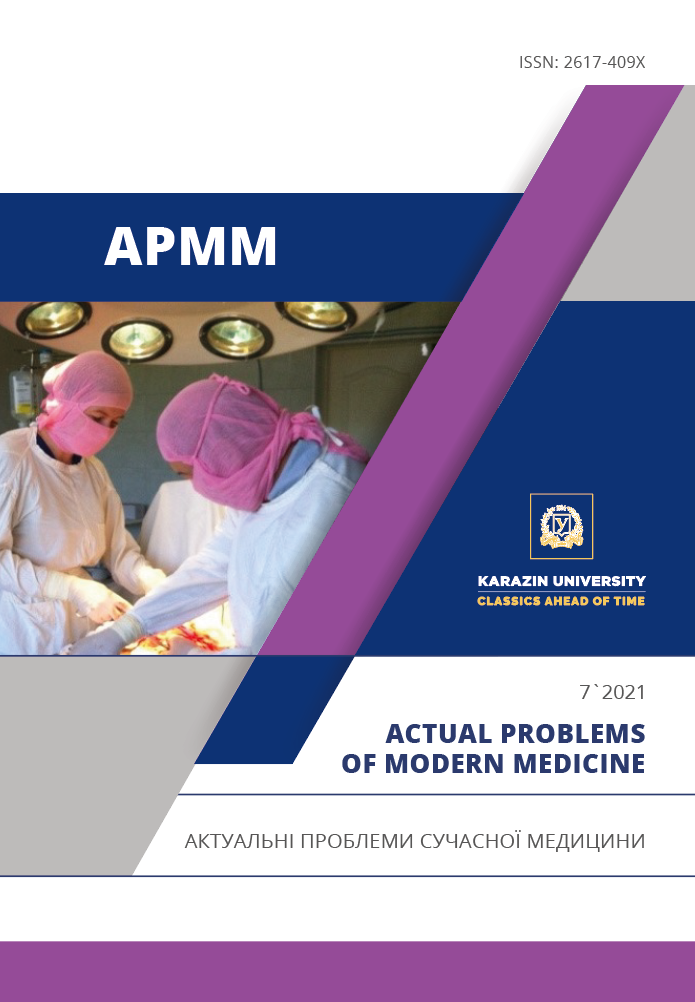Особливості клінічного перебігу корової інфекції під час спалаху кору в 2018-2019 роках в Україні
Анотація
Кір являє собою інфекційне захворювання, що характеризується гострим початком, коротким продромальним періодом, наявністю гарякового, катарального та інтоксикаційного синдромів, а також появою типової енантеми та екзантеми. Не дивлячись на активну роботу ВООЗ з елімінації кору та впровадження програми вакцинації у країнах, що розвиваються, кір залишається актуальною проблемою та причиною високих показників смертності як серед дитячого, так і серед дорослого населення. Одним з небезпечних ускладнень корової інфекції є ураження респіраторного тракту у вигляді позагоспітальних пневмоній, розвиток якої спостерігається у 10-34% хворих. Серед пацієнтів КЗОЗ КНП ХОР ОКІЛ, що знаходились на стаціонарному лікування з приводу корової інфекції, позагоспітальна пневмонія була одним з основних ускладнень та реєструвалась як у пацієнтів з тяжким перебігом захворювання, так і у хворих з середньотяжкою хворобою. Саме тому цікавим уявлялось вивчення клініко-лабораторних особливостей перебігу корової інфекції у дорослого населення на сучасному етапі. Мета дослідження. Вивчення клінічних особливостей перебігу кору та факоторів, що є передумовою розвитку ускладнень. Матеріали і методи. У дослідження було включено 65 пацієнтів, що знаходились на лікуванні у КЗОЗ КНП ХОР ОКІЛ в період з 2018 по 2019 роки з діагнозом «кір». В залежності від тяжкості перебігу захворювання та наявності ускладнень пацієнти, залучені у дослідження, були розподілені на 4 групи. Контрольну групу складали 20 здорових добровільних донорів, що на момент відбору зразків крові не мали критеріїв виключення. Усім пацієнтам в день надходження до стаціонару та на 10й день перебування у стаціонарі на підставі даних клинічного аналізу крові проводився розрахунок лейкоцитарних індексів клітинної реактивності (ЛІКР) – індексу зсуву лейкоцитів (ІЗЛ), лейкоцитарного індексу (ЛІ) та індексу імунологічної реактивності за Д.А.Івановим (ІІР). Результати та обговорення. При проведенні дослідження було показано, що пацієнти 1 та 2 груп на 10й день перебування у стаціонарі демонстрували повне одужання а виписувались зі стаціонару, у той час як пацієнти 3 та 4 груп на 10й день перебування демонстрували лише покращення клінічного стану та переводились у загальне відділення для продовження лікування. Вивчення показників ЛІКР в день надходження до стаціонару продемонструвало підвищення ІЗЛ у пацієнтів 2, 3 та 4 груп, при чому найбільше підвищення спостерігалось у пацієнтів 4 групи. У пацієнтів 1 групи, навпаки, було виявлено зниження ІЗЛ та підвищення ІЛ, що свідчить про активацію лімфоцитарної ланки імунної відповіді. Висновки. Розвиток корової інфекції у дорослого населення характеризується змінами показників лейкоцитарних індексів клітинної реактивності, що є маркерами функціональної активності імунної системи. Середньотяжкий перебіг захворювання супроводжується тенденцією до нормалізації показників, що характеризують активність запального процесу, тоді як тяжкий його перебіг характеризується підвищенням значень вказаних показників та та зниженням активності лімфоцитарної ланки імунної відповіді. Оцінка змін показників лейкоцитарних індексів в динаміці дає змогу спрогнозувати клінічний перебіг захворювання та ризик розвитку ускладнень, оцінити адекватність терапії, що проводиться, а також виявити необхідність проведення імунокорегуючої терапії.
Завантаження
Посилання
Laksono BM, Vires de RD, McQuaid S, Duprex WP, Swart de RL. Measles virus host invasion and pathogenesis. Viruses. 2016;8(8):210. https://doi.org/10.3390/v8080210
Riabokon YuYu, Bilokobyla SO, Riabokon OV. Current course of measles in adults (a literature review). Zaporozhye Med. J. 2019;21(5):697‒701. https://doi.org/10.14739/2310-1210.2019.5.179480
Ponezheva ZhB, Arakelian AK, Kozlova MS, Vdovina ET. Measles in adults. Epidemiology and infectious diseases: topical issues. 2018;2:50‒55. https://doi.org/10.18565/epidem.2018.2.50-5
Naim HY. Measles virus: A pathogen, vaccine and a vector. Hum Vaccin Immunother. 2015;11(1):21‒26. https://doi.org/10.4161/hv.34298
Soloviev SA. Antiviral immunity: Lecture. Respiratory Physiology and Pathology Bulletin. 2015;6:113‒118. Available from: https://cfpd.elpub.ru/jour/article/view/709/639
Diane E. Griffin. The Immune Respose in Measles: Virus Control, Clearance and Protective Immunity. Viruses. 2016;8(10):282. https://doi.org/10.3390/v8100282
Laksono BM, Vries de RD, Verburgh RJ, Visser EG, Jong de A, Fraaij PLA, et al. Studies into the mechanism of measles-assotiated immune suppression during a measles outbreak in Netherlands. Nat. Commun. 2018;9:4944. https://doi.org/10.1038/s41467-018-07515-0
Li J, Zhao Y, Liu Z, Zhang T, Liu C, Liu X. Clinical report of serious complications associated with measles pneumonia in children hospitalized at Shegjing hospital, China. J. Infect Dev Ctries. 2015;9:1139‒1146. https://doi.org/10.3855/jidc.6534
Hussain S, Yasir M, Tarar S, Sabir M. Measles demographic profile and associated morbidities of measles cases admitted in a teaching hospital. PAFMJ. 2016;66(1):92‒7. Available from: https://pafmj.org/index.php/PAFMJ/article/view/319
Schoini P, Karampitsakos T, Avdikou M, Athanasopoulou A, Tsoukalas G, Tzouvelekis A. Measles pneumonitis. Adv Respir Med. 2019;87(1):63‒67. https://doi.org/10.5603/ARM.a2019/0010
Henneman PL, Birnbaumer DM, Cairns CB. Measles pneumonitis. Ann. Emerg. Med. 1995;3(23):278–282. https://doi.org/10.1016/s0196-0644(95)70072-2
Golub AP, Duda OK, Sukhov YuO. Features of the lesion of the respiratory system in patients with measles. Medicines of Ukraine plus. 2018:1(34):10–13. Available from: http://www.health-medix.com/articles/liki_ukr_plus/2018-03-14/3.pdf
Speranskii II, Samoilenko EG, Lobachieva MV. Complete blood count - are all its possibilities exhausted? Integral indices of intoxication as criteria for assessing the severity of endogenous intoxication, its complications and the effectiveness of treatment. Acute and emergency conditions in the practice of a doctor. 2009;6(19). Available from: https://urgent.com.ua/ru-issue-article-293
Ivanov DA, Shabalov NP, Shanalov NN, Kurzina EA, Kostiuchek IN. Leukocyte indices of cellular reactivity as an indicator of the presence of hypo- and hyperergic variants of neonatal sepsis. MedLinks.ru. 2005. Available from: http://www.medlinks.ru/article.php?sid=22330




